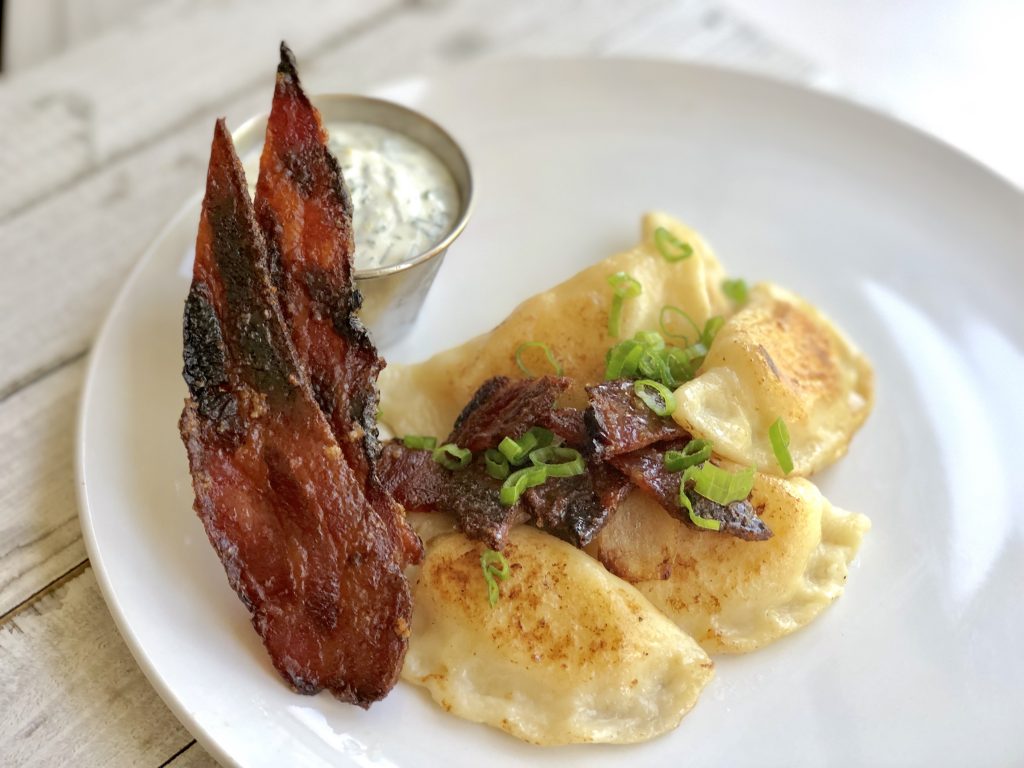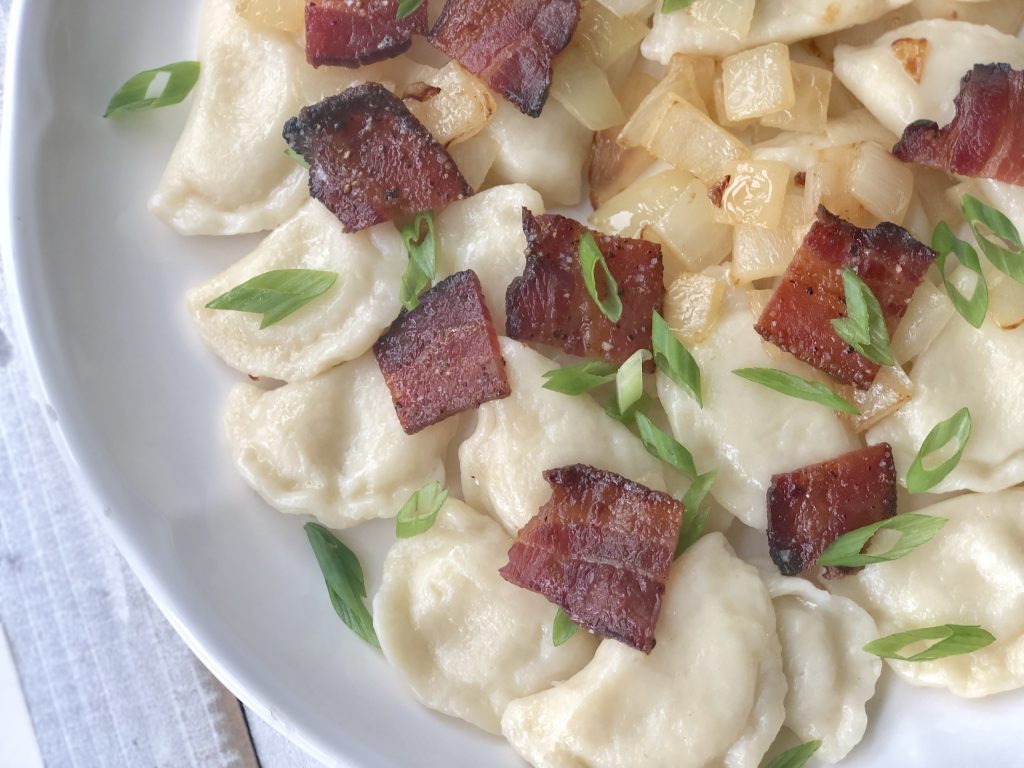Perogies are beloved all over North America and beyond, making them one of Eastern Europe’s most famous culinary contributions. But to make truly amazing perogies, you need to understand the science behind a good dough!
These little dumplings are perfect for parties or potlucks, and the best part? You can make them ahead and freeze them, so they’re ready in minutes whenever you need them! They’re always a crowd-pleaser, especially when you elevate the flavors with some creative toppings.
Personally, I’m not usually a fan of the classic carb-on-carb combo that is the traditional perogy, but I respect their place in the culinary world. So, if we’re going to make them, let’s make them right and pack them with as much flavor as possible! Think sautéed onions, a creamy dill sauce, and even candied bacon for a sweet and salty twist. I’m already dreaming up fall-inspired variations with butternut squash, toasted pine nuts, crisp sage, and brown butter. Flavor, flavor, flavor!
For this recipe, I’m topping my perogies with green onions, sautéed yellow onions, and yes, candied bacon. It may not be traditional, but it’s so worth it. Regular bacon works great too!
When making the filling, you have all the control in the world. Make sure it’s seasoned well with salt and adjust it as needed before adding it to the dough. Maybe it needs a touch more black pepper or a pinch of onion powder. Get creative! Try a blend of white cheddar and mozzarella for a fluffy, light-colored filling that melts beautifully.
The Science Behind Perfect Perogy Dough:
The dough for perogies is similar to pasta or gnocchi—unleavened and simple. But the magic lies in the technique:
- Minimal Gluten Development: Unlike pizza dough, you don’t want to overwork this dough. We’re looking for just enough elasticity to hold everything together without becoming tough. Minimal kneading means a more tender bite.
- Use Potato Water: Add some starch to the dough for better spreadability and texture. No need to buy potato starch—just use the water you boiled your potatoes in! This starchy water helps create a dough that’s less sticky and easier to work with.
- Let the Dough Rest: After mixing, let the dough sit for 30-60 minutes on the counter. This resting time relaxes the gluten, making it more pliable and tender.
A Few Final Tips:
The recipe I’m sharing results in perfect perogies time after time, but feel free to experiment! You can even swap some of the liquid for sour cream or milk to change up the texture.
Oh, and one last thing: The word “perogies” itself has an interesting history! Technically, “perogi” is already plural, and the singular is “perog.” In Ukrainian, the “i” functions similarly to an “s” in English, making words plural. Also, “pedaheh” is likely a Canadian-American interpretation of the original term. Fun fact: Across parts of Eastern Europe, what we call “perogies” here in North America is actually known as “varenyky.” Growing up in Ukraine, I never heard these dumplings called “perogi,” but that’s the beauty of food—it evolves and takes on new identities depending on where you are!
For this variation, I’ve seared the perogies in butter until golden and topped them with candied bacon. Hope you give these a try!

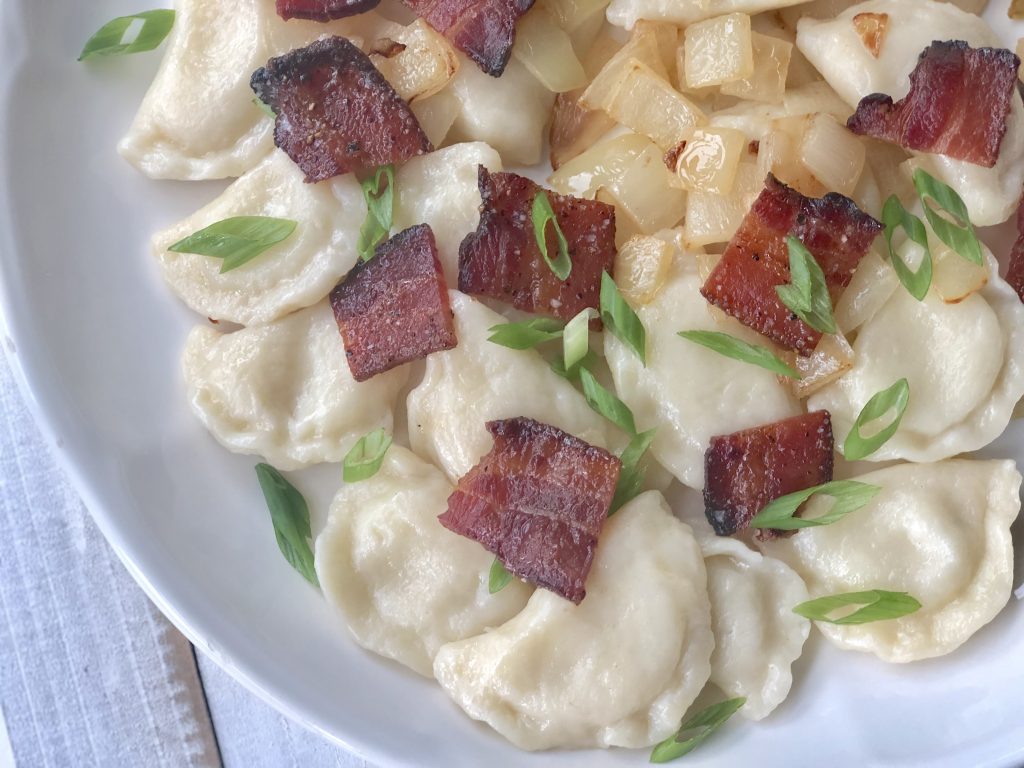
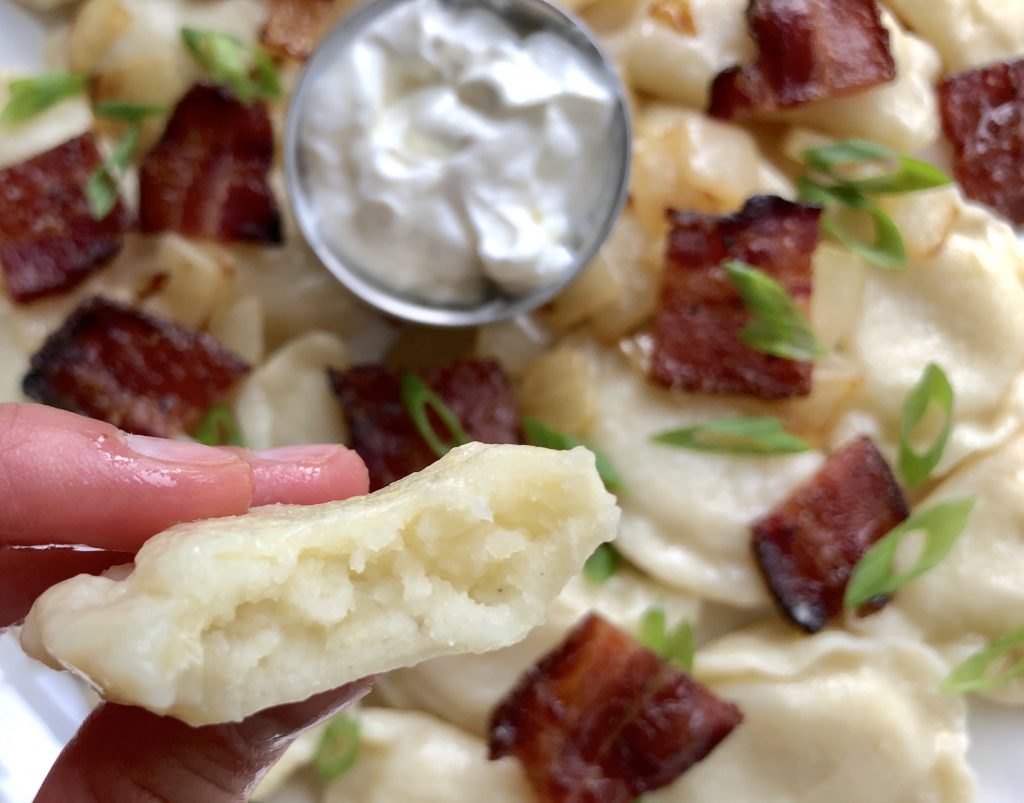
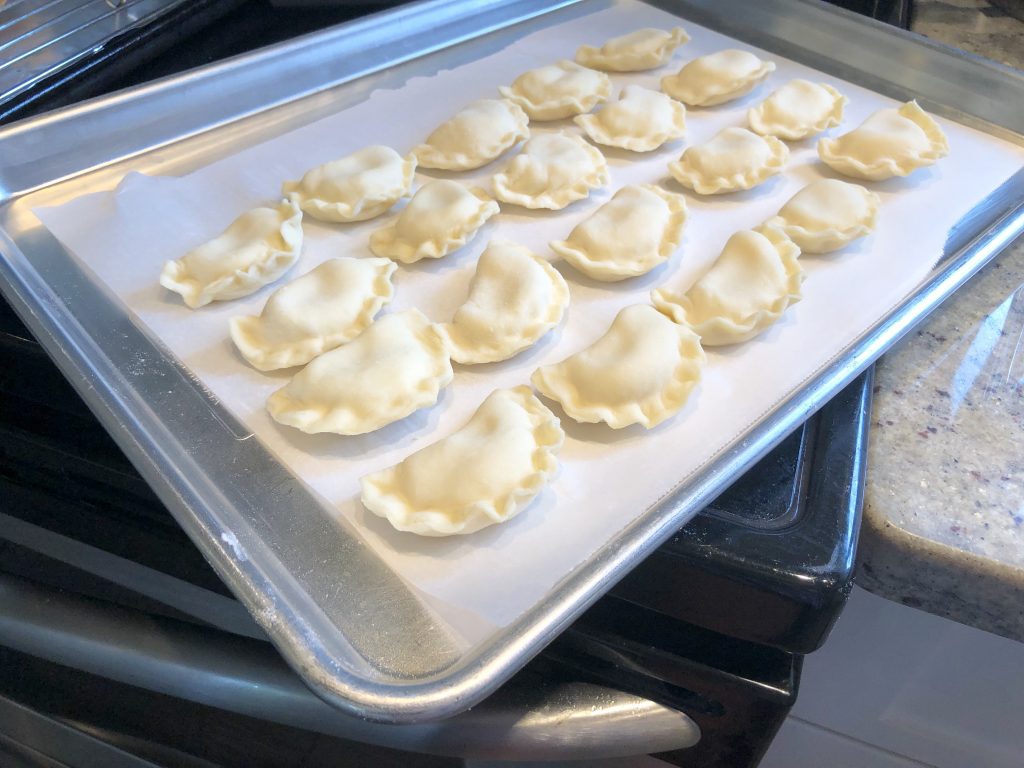
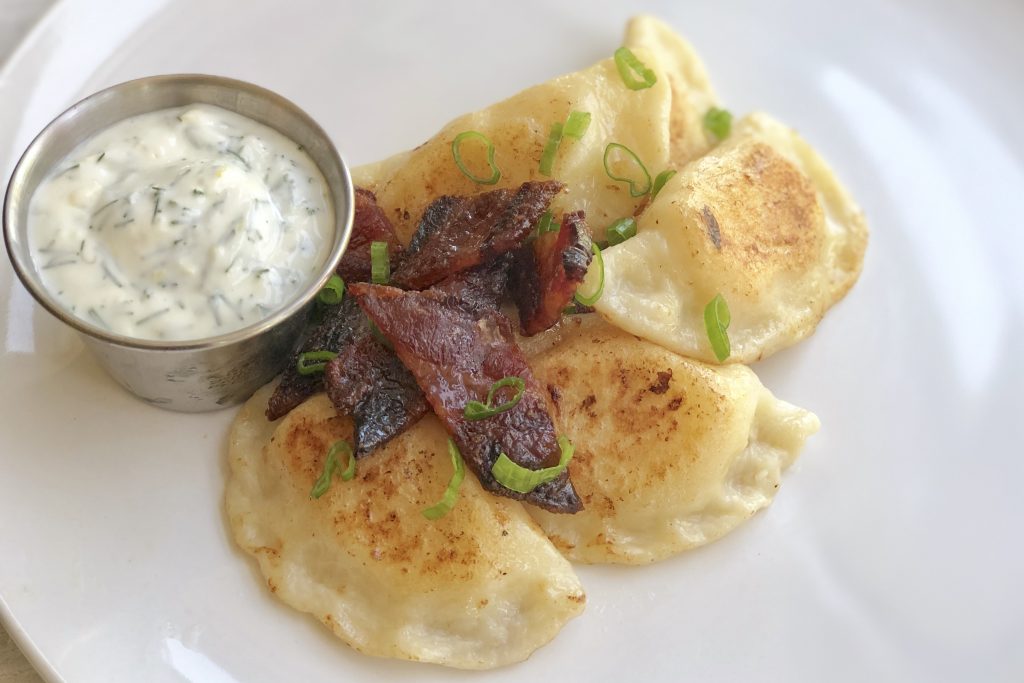
💡 Science Tip for Perogies:
Perfect Dough Hydration and Tenderness:
Achieving the ideal dough texture for perogies involves finding the right balance of hydration and gluten development. The secret? Use the starchy potato water left over from boiling your potatoes! The starch in this water helps hydrate the flour without making the dough sticky. It also acts as a natural tenderizer, giving your dough a softer, more pliable texture. Additionally, let the dough rest for at least 30 minutes after mixing. This resting period allows the glutens to relax, making it easier to roll out and less likely to spring back when you shape your perogies. This ensures the dough stays tender and doesn’t become tough or chewy after boiling! 🥟
Please read notes before proceeding with this recipe.
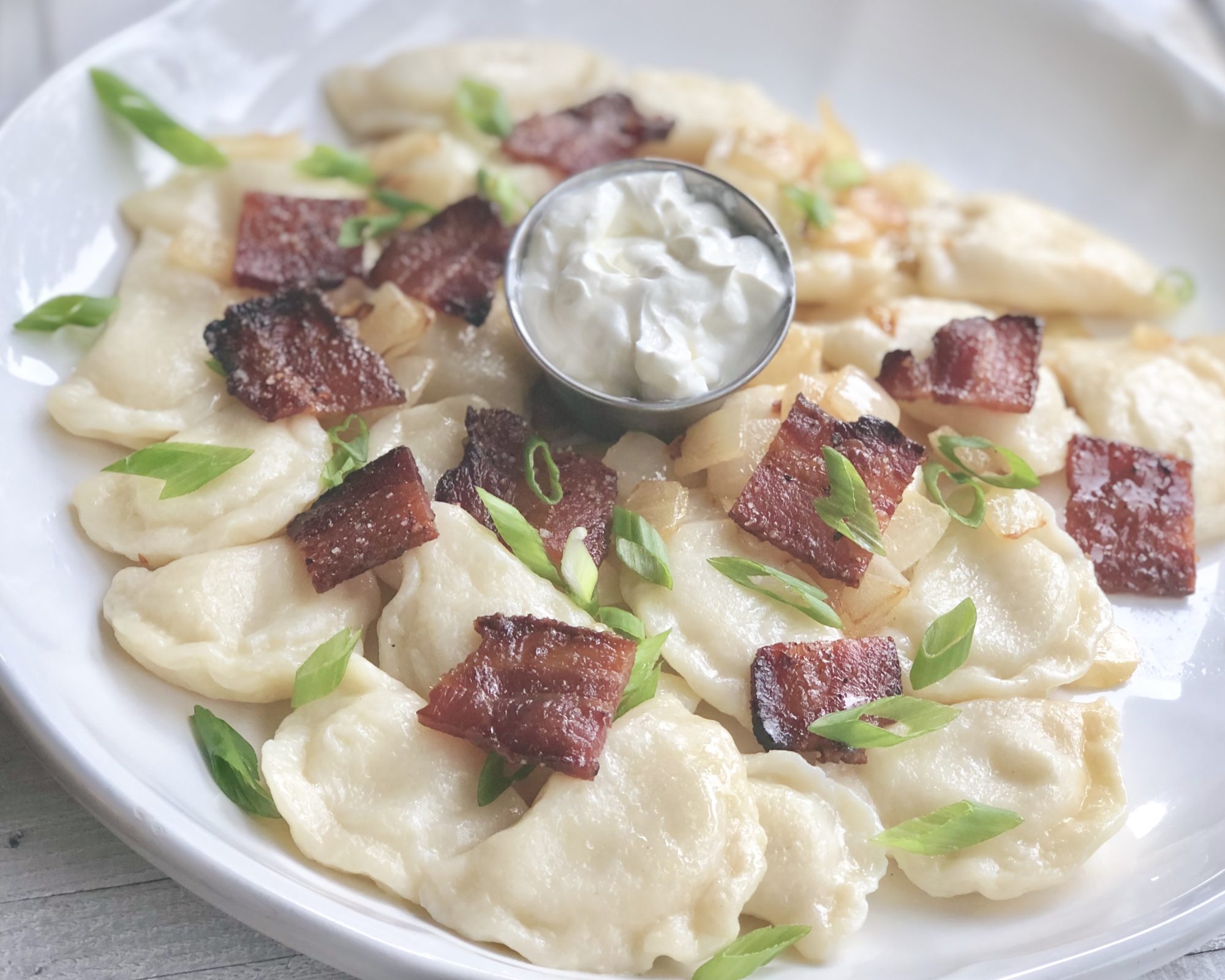
Peel potatoes and chop into 1.5 inch chunks. Place in a pot of cold water, add some salt. Bring to boil, reduce the heat to medium, cover and simmer for 25-30 minutes until very tender. Drain the potatoes reserving the potato water (SEE NOTE.) Cover the drained potatoes and let them sit for a minute or so. They will steam a bit for lighter texture. Gently mash the potatoes with a potato masher until very smooth.
Gently fold in some butter, shredded cheese, onion powder and some salt (remember, cheddar cheese is quite salty so you may not need a lot of salt.) You are looking for smooth texture that you can roll in a ball. You don't want your potatoes too firm, but you also don't want them too runny. They should be soft yet hold their shape to be rolled into a ball. Add a smalls plash of milk milk, sour cream or cream cheese, if needed to reach the right texture. Handle the potatoes gently while mixing to retain their fluffy texture and avoid gumminess. Cover your potatoes with a lid slightly ajar to cool them slightly yet avoid drying them out.
In a bowl of your stand mixer, mix egg, salt, sour cream and reserved potato water until well combined.
Make sure your potato water is not hot or it will scramble the egg. It's okay if your potato water is warm - just be sure to whisk everything together as soon as you add it, since gradually warming the egg will prevent it from scrambling.
Add 1 cup of flour and mix it with a fork until combined. Add another 3/4 cup and start kneading with the dough hook. At this point, switch to a spoon and start adding your flour one tablespoon at a time until the dough no longer sticks to the side of the bowl. If you add too much flour, the dough may be too dense, but not adding enough flour will also pose a problem and result in sticky unworkable dough. After you have observed the dough is no longer sticking to the bowl, mix it with your hands a couple of times (stop the mixer first,) ensuring it's not sticky, and when you are satisfied knead on low (speed 2) for about 2 minutes until the dough is smooth and elastic. Do not over knead. The amount of flour needed will generally vary between 2 cups and 2 1/4 cups, sometimes even humid weather outside can affect the exact amount of flour needed.
You can easily do this step by hand! You may need to knead for a bit longer if doing it by hand.
Let the dough rest on the counter, tightly covered with plastic wrap for 30-60 minutes. This is very important in order for the glutens in your dough to relax and for the dough to be soft and easy to work with.
Roll the dough out on lightly floured surface to 1/8" thickness, or just under; 3-4mm. With a 3" cookie cutter cut the dough into rounds. Remove scraps, if you plan to re-use them to roll more perogies, gently knead them back into smooth dough, cover with plastic wrap and let rest for 15-30 minutes. Figure out how much filling you can comfortably get in the middle of each dough round while still being able to seal it - it will likely be about 1 or 1.5 teaspoons. The goal is to add a generous amount of filling, while still being able to pull the dough over it and seal it; if the filling gets into the edge - it won't seal properly. So find the maximum amount of filling you can use without jeopardizing the seal.
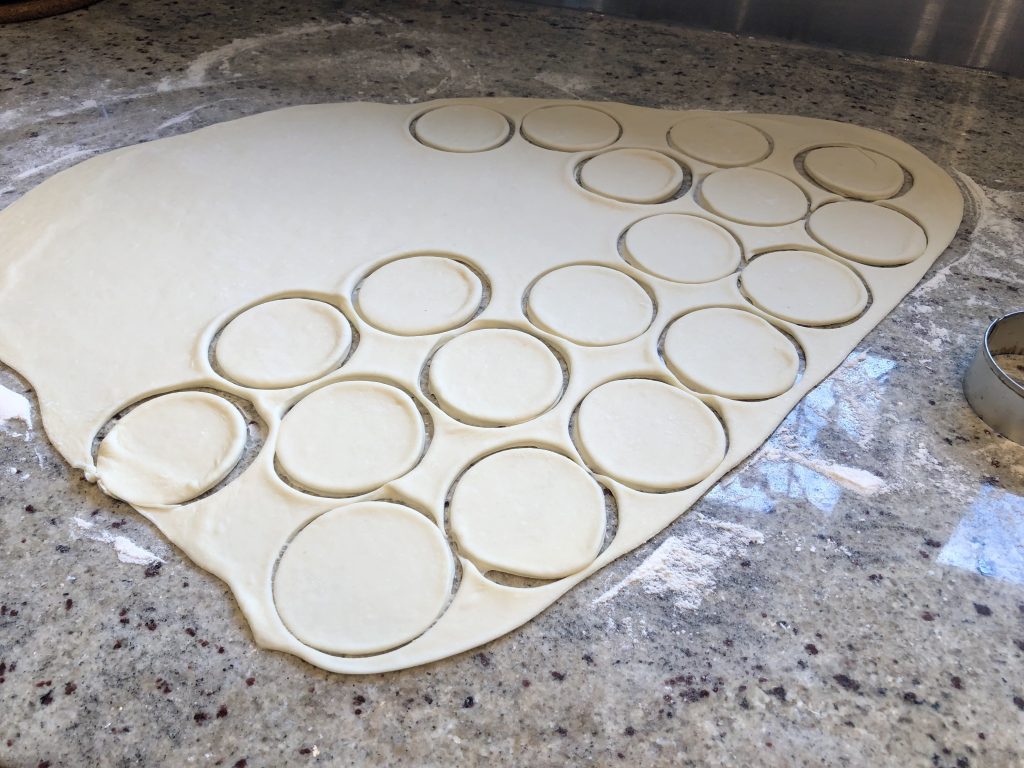
Roll the filling into balls. It helps to roll the filling, as this way it won't get all over your fingers and get into the edge of your perogie rounds, making it difficult to seal.



Turn each dough circle over. Think about it - the top of it is starting to dry out and it would be nearly impossible to seal while the side touching your counter space is nice and sticky. Place a ball of filling on top of your inverted dough circle.
Pull the edges of each perogie round together and pinch to seal. At this point, you are not crimping the edges, that will come later. Manipulate the filling and the shape of the perogie into the crescent shape. Set aside. Finish with the remaining dough circles.
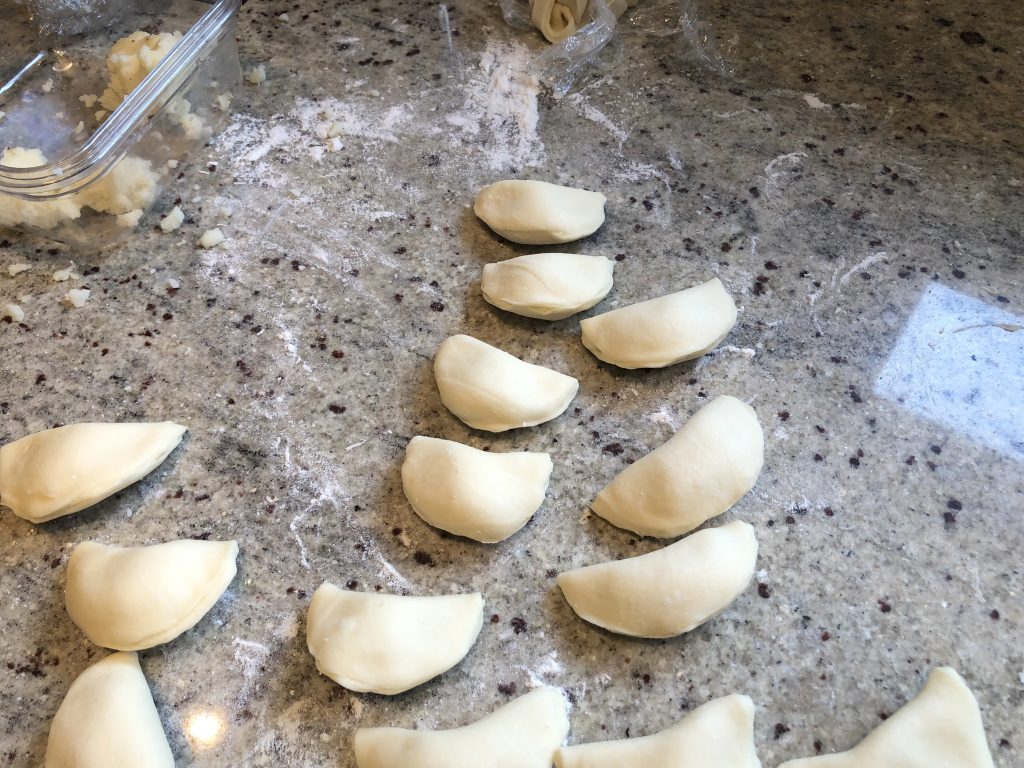


Now, that the edges of each perogie firmed up a bit, the gluten in them has relaxed and they even dried a bit - crimping the edges into a decorative pattern will be very easy to do. So proceed crimping each perogie with you index finger and your thumb in a pinch and twist motion. You will quickly get a hang of what looks good!
Proceed to the next step or flash freeze perogies by placing them in a single layer on a baking sheet and freezing for an hour or two; after that point transfer them to a large freezer bag or freezer-safe container.
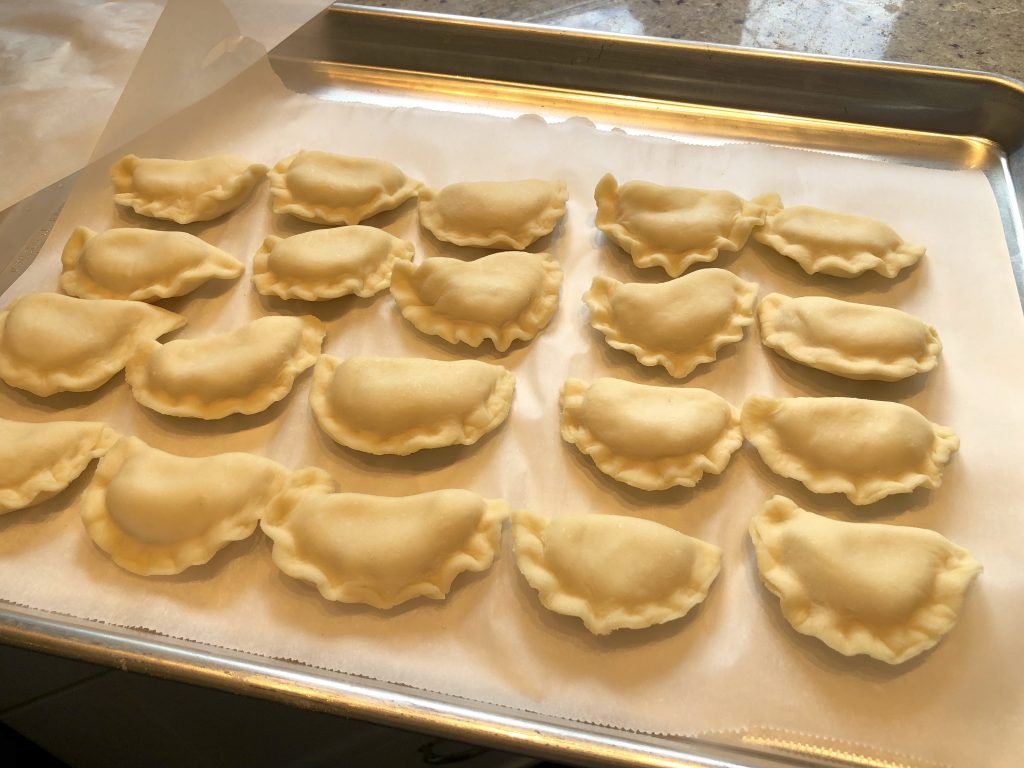


Bring a pot of salted water to boil. Add perogies to the pot. Once they float and the water returns back to a boil - cook them for 3-5 minutes until they are cooked through and the dough is tender. Serve them with your favourite garnishes. Traditionally these are served with some butter, sautéed onions and bacon.
In addition, after boiling, you may also fry your perogies on each side until golden. Enjoy
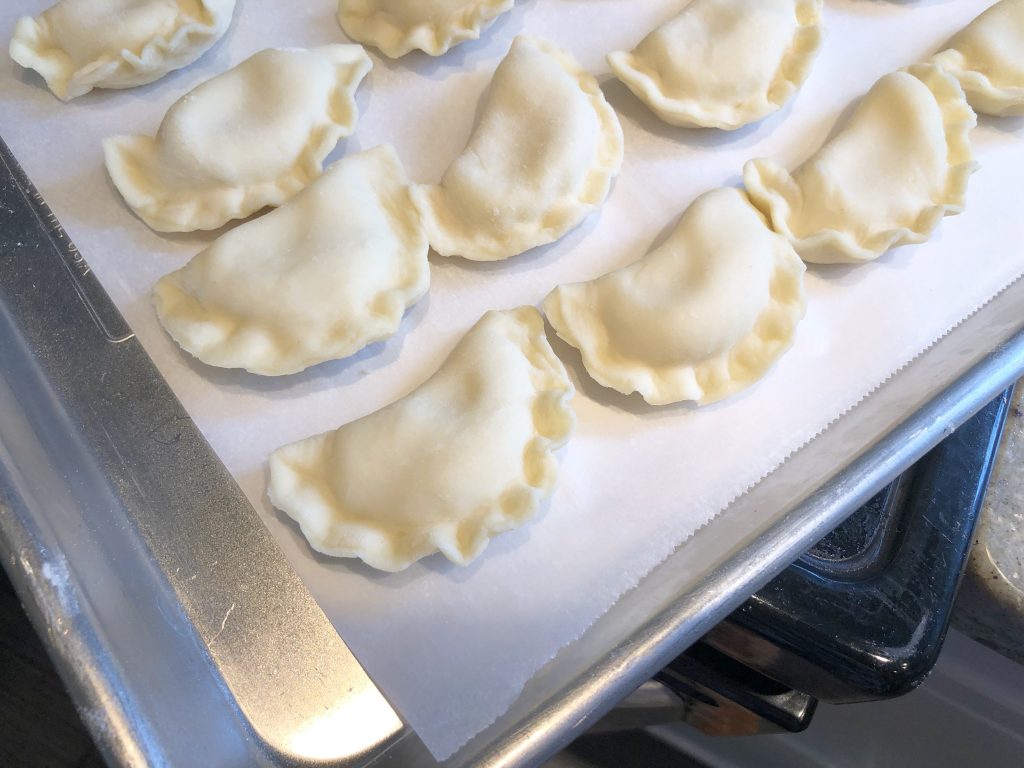


Potato water is very important as the potato starch in it will help the dough spread out easier and make it softer and easier to work with. Feel free to mash a good chunk of boiled potato into the water, to make the potato starch even more concentrated. Look at the picture attached. I separated my potato water - the starchiest water will be added to the dough.
This filling amount is a bit more than needed. You can probably get away with 2 potatoes, however, I always make 3 and just snack on leftovers. It's better than going through all the work and ending up not having enough.
Don't re-roll your dough more than once. The gluten will become quite overworked and your dough won't be as tender.
Get creative with your filling. My go to is cheddar cheese. But sometimes I use half white cheddar cheese and half mozzarella. I find the colour of white fluffy filling quite appetizing. Make sure to make your filling taste good - this is the star of your perogie. Ensure to add enough salt to it. Bland filling will result in a bland perogie. Sour cream adds a nice zing, so does cream cheese - so add enough to get a flavourful filling with the right texture.
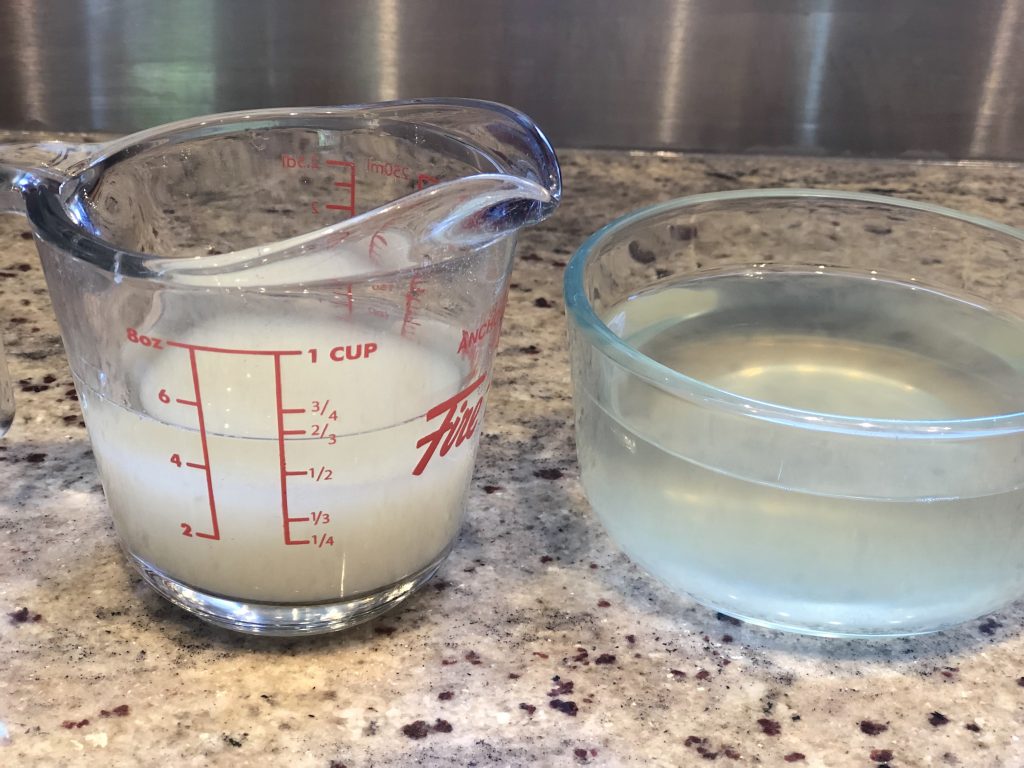


Ingredients
Directions
Peel potatoes and chop into 1.5 inch chunks. Place in a pot of cold water, add some salt. Bring to boil, reduce the heat to medium, cover and simmer for 25-30 minutes until very tender. Drain the potatoes reserving the potato water (SEE NOTE.) Cover the drained potatoes and let them sit for a minute or so. They will steam a bit for lighter texture. Gently mash the potatoes with a potato masher until very smooth.
Gently fold in some butter, shredded cheese, onion powder and some salt (remember, cheddar cheese is quite salty so you may not need a lot of salt.) You are looking for smooth texture that you can roll in a ball. You don't want your potatoes too firm, but you also don't want them too runny. They should be soft yet hold their shape to be rolled into a ball. Add a smalls plash of milk milk, sour cream or cream cheese, if needed to reach the right texture. Handle the potatoes gently while mixing to retain their fluffy texture and avoid gumminess. Cover your potatoes with a lid slightly ajar to cool them slightly yet avoid drying them out.
In a bowl of your stand mixer, mix egg, salt, sour cream and reserved potato water until well combined.
Make sure your potato water is not hot or it will scramble the egg. It's okay if your potato water is warm - just be sure to whisk everything together as soon as you add it, since gradually warming the egg will prevent it from scrambling.
Add 1 cup of flour and mix it with a fork until combined. Add another 3/4 cup and start kneading with the dough hook. At this point, switch to a spoon and start adding your flour one tablespoon at a time until the dough no longer sticks to the side of the bowl. If you add too much flour, the dough may be too dense, but not adding enough flour will also pose a problem and result in sticky unworkable dough. After you have observed the dough is no longer sticking to the bowl, mix it with your hands a couple of times (stop the mixer first,) ensuring it's not sticky, and when you are satisfied knead on low (speed 2) for about 2 minutes until the dough is smooth and elastic. Do not over knead. The amount of flour needed will generally vary between 2 cups and 2 1/4 cups, sometimes even humid weather outside can affect the exact amount of flour needed.
You can easily do this step by hand! You may need to knead for a bit longer if doing it by hand.
Let the dough rest on the counter, tightly covered with plastic wrap for 30-60 minutes. This is very important in order for the glutens in your dough to relax and for the dough to be soft and easy to work with.
Roll the dough out on lightly floured surface to 1/8" thickness, or just under; 3-4mm. With a 3" cookie cutter cut the dough into rounds. Remove scraps, if you plan to re-use them to roll more perogies, gently knead them back into smooth dough, cover with plastic wrap and let rest for 15-30 minutes. Figure out how much filling you can comfortably get in the middle of each dough round while still being able to seal it - it will likely be about 1 or 1.5 teaspoons. The goal is to add a generous amount of filling, while still being able to pull the dough over it and seal it; if the filling gets into the edge - it won't seal properly. So find the maximum amount of filling you can use without jeopardizing the seal.



Roll the filling into balls. It helps to roll the filling, as this way it won't get all over your fingers and get into the edge of your perogie rounds, making it difficult to seal.



Turn each dough circle over. Think about it - the top of it is starting to dry out and it would be nearly impossible to seal while the side touching your counter space is nice and sticky. Place a ball of filling on top of your inverted dough circle.
Pull the edges of each perogie round together and pinch to seal. At this point, you are not crimping the edges, that will come later. Manipulate the filling and the shape of the perogie into the crescent shape. Set aside. Finish with the remaining dough circles.



Now, that the edges of each perogie firmed up a bit, the gluten in them has relaxed and they even dried a bit - crimping the edges into a decorative pattern will be very easy to do. So proceed crimping each perogie with you index finger and your thumb in a pinch and twist motion. You will quickly get a hang of what looks good!
Proceed to the next step or flash freeze perogies by placing them in a single layer on a baking sheet and freezing for an hour or two; after that point transfer them to a large freezer bag or freezer-safe container.



Bring a pot of salted water to boil. Add perogies to the pot. Once they float and the water returns back to a boil - cook them for 3-5 minutes until they are cooked through and the dough is tender. Serve them with your favourite garnishes. Traditionally these are served with some butter, sautéed onions and bacon.
In addition, after boiling, you may also fry your perogies on each side until golden. Enjoy



Potato water is very important as the potato starch in it will help the dough spread out easier and make it softer and easier to work with. Feel free to mash a good chunk of boiled potato into the water, to make the potato starch even more concentrated. Look at the picture attached. I separated my potato water - the starchiest water will be added to the dough.
This filling amount is a bit more than needed. You can probably get away with 2 potatoes, however, I always make 3 and just snack on leftovers. It's better than going through all the work and ending up not having enough.
Don't re-roll your dough more than once. The gluten will become quite overworked and your dough won't be as tender.
Get creative with your filling. My go to is cheddar cheese. But sometimes I use half white cheddar cheese and half mozzarella. I find the colour of white fluffy filling quite appetizing. Make sure to make your filling taste good - this is the star of your perogie. Ensure to add enough salt to it. Bland filling will result in a bland perogie. Sour cream adds a nice zing, so does cream cheese - so add enough to get a flavourful filling with the right texture.



Notes
